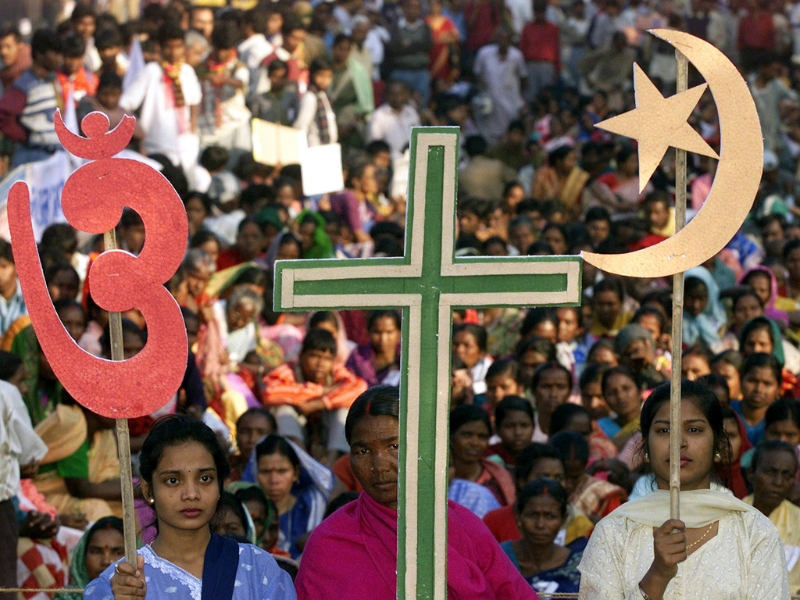By: ilma hasan
May 11 2024
Reporting on growth of India's Muslim population is misleading

File photo of Indian women holding religious symbols. (Source: Reuters)
A working paper released by India’s Economic Advisory Council to the Prime Minister has stated that the country’s share of Muslim population had increased by over 43 percent, while the Hindu population had decreased by 7.8 percent between 1950 and 2015.
Raising concerns over this paper analyzing the population compositions between majority and minority religious groups over a 65-year period globally, the Population Foundation of India (PFI), a non-governmental organization, called it “misrepresentation” and highlighted that the “decadal growth rate for Muslims has been declining over the past three decades.”
The paper studied the share of religious minorities in 167 countries, including India. However, the ‘43 percent rise in share of Indian Muslims’ immediately made headlines, with many reports repeating the key finding without providing additional context. It was also used to propagate the oft-repeated narrative that the Muslims will overtake Hindus in India. Some archive links can be seen here, here, here, here, and here.

Screenshot of users repeating the claim on social media. (Source: X/Screenshot)
The narrative was further stoked by leaders from the ruling Bharatiya Janata Party (BJP). Amit Malviya, BJP’s IT Cell head, shared a post on X (formerly Twitter) and blamed the Opposition Congress for it.
Citing the report, Union IT Minister Rajeev Chandrashekhar said, “One particular community is increasing in population, where the demography of India is being altered. What is the impact of this increase on the rights of other minority communities? There is a huge attempt by some parties, Congress to alter the Constitution and bring religion-based reservation. What is the consequence of it on OBC, SC and ST communities?”
Chandrashekhar was alluding to the rhetoric that has gained traction amid polling that falsely alleges that the manifesto of the Congress party promises reservation for Muslims. Further, the narrative about Muslims increasing the population has been debunked several times in the past. While it is undeniable that the Muslim community has the highest fertility rate, it is also true that the rate has seen a sharp decline over the years.
Now, let’s also look at how the numbers add up against or in favor of the Muslim population explosion narrative.
What does data show?
With India’s last census conducted in 2011, right-wing groups and voices have used the lack of data to repeatedly claim India’s Muslim population is significantly increasing. They also say it will be aided by the minority community having higher fertility rates.
However, in absolute numbers, in 2001 the Hindu population was at 828 million (82.8 crore), while the Muslim population was at 138 million (13.8 crore). It grew to 966 million (96.6 crore) for the Hindu community in 2011 and 172 (17.2 crore) million for the Muslims in the same period.
When comparing the growth rates, Muslims grew by 24.7 percent while Hindu population grew by 16.7 percent between 2001-2011. The growth rate of both the Hindus at 19.92 percent and the Muslims at 29.52 percent have seen a decline from the previous decade (1991-2001).
In percentage terms, between India’s first recorded census in 1951 and 2011, Pew Research analyzed Muslims grew by 4.4 percentage points and Hindus declined by 4.3 percentage points.
In 1951, India’s Hindu population share was 84.1 percent, while Muslim’s constituted nearly ten percent (9.80 percent). In the 2011 census, the Muslim population had risen to 14.2 percent, while the Hindu population was at 79.8 percent. In 2020, Pew Research projected Muslim population to be about 15 percent, a marginal 0.8 percent rise from the last conducted census in 2011, and the Hindu population was estimated at 79 percent, a 0.8 percent decline from the last census.
While Muslims did grow at a rate higher than the average, it has slowed down in the last few decades. Pew Research also found that while the numbers of India’s other religious minorities have increased over the years, their share in India’s population has remained steady.
Taken out of context
Criticizing the alarm being raised over the new report, PFI in a statement said it is, “deeply concerned about the recent media reports that are misreporting the findings from the study to spread alarm regarding the growth of the Muslim population. Such interpretations are not only inaccurate but also misleading and baseless.”
“The media’s selective portrayal of data to highlight the increase in the Muslim population is an example of misrepresentation that ignores broader demographic trends,” Executive Director Poonam Muttreja said.
The report stipulated that the population of Muslims had increased by over 43 percent between 1951 and 2015 by calculating the difference in the community’s share of population in that time period. It also concluded that the Christian population rose by 5.38 percent and Sikhs by 6.58 percent.
However, using the paper's methodology, the difference change in the Sikh population is 49 percent — 1.24 percent in 1950 to 1.85 percent in 2015. The paper also doesn’t mention the percent changes in the Buddhist and Jain population, but if the same methodology is applied then the Buddhist population grew by 1,520 percent — 0.05 percent in 1950 to 0.81 percent — and Jain population decreased by 20 percent.
The paper states that 33 of the 35 OECD (Organization for Economic Co-operation and Development) countries witnessed “a decline in the share of the majority religious denomination”.
Shamika Ravi, one of the authors of the paper, told The Print, “Each country has its own complicated history, that is why we are not looking at the different factors, just the net share. And we’re saying if the share of minorities rises the null hypothesis you have an environment which is conducive to minority welfare.”
The report merely calculates the net changes in population shares of various religious groups without taking into consideration other factors.


